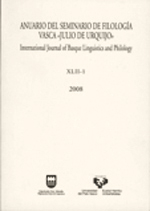Filled-gap effects in sentence processing: different accounts compared
##plugins.themes.bootstrap3.article.main##
##plugins.themes.bootstrap3.article.sidebar##
Laburpena
It is widely accepted that the human sentence parsing mechanism is subject to real-time constraints that demand some decisions to be made on-line. One of the areas of research in sentence processing has been to look at how long-distance dependencies where there is a relation between a fronted phrase ('filler') and its canonical position ('gap') are constructed on-line. These dependencies where there is an element that has been displaced are interesting to examine because they provide relevant cues for how sentence interpretation proceeds when the information that can be used to interpret the sentence is not immediately available. Research on the processing of long-distance dependencies has focused on different questions. One of the questions was directed to examine the specific point in time and the position in the sentence at which the parser posits gaps while processing long-distance dependencies. The other was to examine how the fronted phrase is interpreted and if the verb is necessary to interpret the dislocated phrase.
This paper focuses on the different approaches that have been suggested to explain how long-distance dependencies are processed and how the fronted phrase gets interpreted. The objective is to look at whether the verb is completely necessary when trying to interpret information on-line. Bearing this in mind, I examine how the different processing theories account for the results of an experiment on clitic pronouns in Spanish. I compare parsing theories that presuppose the existence of gaps, parsing theories that presuppose a direct semantic association and HPSG theories against the Spanish data and conclude that there is pre-verbal information such as clitic pronouns that can be used to interpret displaced elements in sentence processing.
Nola aipatu
##plugins.themes.bootstrap3.article.details##
Lan hau Creative Commons Aitortu-EzKomertziala-LanEratorririkGabe 4.0 Nazioartekoa lizentzia baten mende dago.


